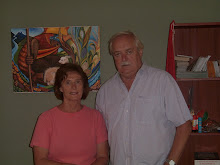
You travel from sea level at Lima to 4,818 metres at the highest point and then drop down to 4,000 metres at Tarma. In fact you reach 4,800 metres twice during the drive, the mining town of La Oroya is a little lower and in between the two high points. That is a very simplistic description of what actually happens! The distance from Lima to Tarma is only 240 kilometres and the driving time was just under six hours. Nevertheless, the road is continually ascending or descending as it winds around the mountains. The surrounding peaks are enormous and the valleys narrow and deep. Because this is one access to the Amazon, via La Merced, the traffic is always heavy - cars, tourist buses and the large trucks laden with timber and fruit from the jungle coming towards you all the time. Not to mention the times you are trying to pass all the slow trucks.

 Tarma is an amazing town situated in an equally amazing valley, thus it has been named ‘The Pearl of the Andes’ and rightly so. It is a huge producer of fresh flowers for the markets in Lima. On my previous visits the flowers were in bloom, however, this time I was too early.
Tarma is an amazing town situated in an equally amazing valley, thus it has been named ‘The Pearl of the Andes’ and rightly so. It is a huge producer of fresh flowers for the markets in Lima. On my previous visits the flowers were in bloom, however, this time I was too early.The reason for the visit was to attend the 50 year celebrations of the formation of the Catholic Diocese of Tarma. I managed just one event, the Saturday morning Mass at the Tarma indoor basketball stadium; the Cathedral was too small for the crowd. I could not believe the band, the singing and the flag waving crowd, you could not help being swept up in the atmosphere. You just wanted to be part of the crowd. Not bad for a person who only attends the quiet eight o’clock Sunday morning Mass! For half an hour before the start, the Master of Ceremonies spent his time and energy whipping the congregation into a ‘Mass’ frenzy! There was also a character on tall stilts and dressed in an all gold costume assisting with the warm-up activities.

The actual Mass was a very solemn affair and attended by ten Bishops. I did not realise that the cumulative noun for that many Bishops is a ‘bench’ I thought that it may have been a ‘sea of Bishops’!
The Offertory Procession is worth mentioning, it included all the parishes and their representatives were dressed in their traditional attire and carrying local produce to be presented to the Bishop. Even two miners carried up containers of the local minerals with their miners lamps alight. The stilt man went up with his parish group to greet the Bishop.
However, I must mention that I arrived at the stadium at 9.30 a.m. for what I was told a 10.00 start; it began at 11.00 a.m. and was winding up at 1.45 p.m.!
However, I must mention that I arrived at the stadium at 9.30 a.m. for what I was told a 10.00 start; it began at 11.00 a.m. and was winding up at 1.45 p.m.!
After the Mass Leo and I were taken by his friend, Hector, to visit the small town of Huasahuasi where Leo spent many years. If you think the road to Tarma has its moments you are in for a real treat when you travel the fourteen kilometres from the highway to Huasahuasi. Hector did inform us that the authorities had widened the road in some of the more dangerous spots. I must admit that it seemed that two cars could now pass in most spots!
Two views of the road into Huasahuasi We visited the new grave site of Sister Irene McCormack, an Australian Josephite Sister murdered with four others by the Shining Path terrorists on 21st May 1991 in the main Plaza of Huasahuasi. Both Marion and I have visited her grave in the past and it is still an eerie feeling standing before the grave of a murdered fellow Australian so many kilometres from her homeland. Her story is an amazing one an can be followed up through Google. I often find it a chilling reminder that the Shining Path terrorists operated in the 1980’s and early 1990’s and were responsible for over seventy thousand deaths in that time.






My final memory concerning the trip, and a rather light hearted one at that concerns the fact that we stopped for breakfast on the way back to Lima at La Oroya. Leo ordered patasca, a local favourite soup made of potato, corn and sheep ‘bits’, very tasty if you can manage to negotiate the latter! Aldo went one better, his soup contained the entire lamb’s head which he devoured with relish. Not something that one wants to watch at seven in the morning! I settled for my usual, ‘pan con huevo y queso y café solo’ - bread with egg and cheese and a black coffee.
 The mining town of La Oroya on a bleak day.
The mining town of La Oroya on a bleak day.
 The mining town of La Oroya on a bleak day.
The mining town of La Oroya on a bleak day.




